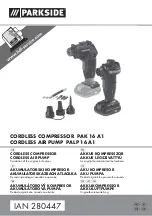
8
9
OPERATION (CONTINUED)
3.
COLD WEATHER STARTING
• Turn the switch to the
OFF
(O) position.
• Turn the tank drain valves counterclockwise to open.
NOTE
: The air compressor has two tanks. Be sure to open both tank drain valves.
• Turn the switch out to the
ON
( l ) position and run the compressor for 1 - 2 minutes.
• Turn the switch to the
OFF
(O) position.
• Turn the tank drain valves clockwise to close.
NOTE
: The air compressor has two tanks. Be sure to close both tank drain valves.
• Follow normal operating procedures.
4.
DRAINING THE TANKS
To help prevent tank corrosion and keep moisture out of the air used, the air tanks of the
compressor should be drained daily.
NOTE
: The air compressor has two separate tanks: an upper tank and a lower tank.
Be sure to open drain valves for both and perform this operation for both tanks.
To drain
:
• Rotate drain valves counterclockwise to open.
• Tilt to drain moisture from tanks into a suitable container.
NOTE
: Condensate is a polluting material and should be disposed of in compliance with local regulations.
• If drain valves are clogged, release all air pressure, remove and clean valves, then reinstall.
Unplug the air compressor and release all air from the tanks before servicing. Failure to
depressurize tanks before attempting to remove valve may cause serious personal injury.
• Rotate drain valves clockwise until tightly closed.
5.
CHECKING THE SAFETY VALVE
Do not attempt to tamper with the safety valve. Anything loosened from this device could fly up
and hit you. Failure to heed this warning could result in death or serious personal injury.
The safety valve will automatically release air if the air receiver pressure exceeds the preset
maximum. The valve should be checked before each day of use by pulling the ring by hand.
• Turn the air compressor on and allow the tanks to fill. The compressor will shut off when
the pressure reaches the preset maximum.
• Turn the air compressor off.
• Pull the ring on the safety valve to release air for twenty seconds.
• Release the ring. Air will stop escaping when the ring is released at approximately 20 PSI.
Any continued loss of air after releasing the safety valve ring indicates a problem with
the safety valve. Discontinue use and seek service before continued use of the air
compressor.
If air leaks below 1.5 BAR (20 PSI) after the ring has been released, or if the valve is stuck and
cannot be actuated by the ring, Do not use the air compressor until the safety valve has been
replaced. Use of the air compressor in this condition could result in serious personal injury.
Содержание BTFP02040
Страница 14: ...11 NOTES 14 ...
Страница 15: ...11 NOTES 15 ...


































